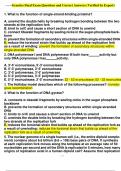Exam (elaborations)
Genetics Final Exam Questions and Correct Answers (Verified by Expert)
- Course
- Institution
Genetics Final Exam Questions and Correct Answers (Verified by Expert) 1 / 24 1. What is the function of single-strand-binding proteins? A. unwind the double helix by breaking hydrogen bonding between the two strands at the replication fork B. bind to oriC and cause a short section of DNA to u...
[Show more]



